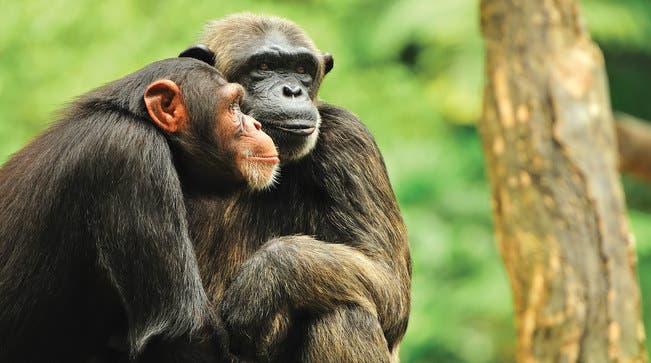The great apes are suffering greatly from Ebola too – gorillas and chimps are facing the greatest threat ever, after Ebola has wiped out a third of the populations since the 1990s.
Ebola and great apes
It’s easy to forget just how similar we are to apes and chimps. We share 94% of our DNA with chimps, and these two species are the closest living evolutionary relatives to humans, sharing a common ancestor with humans about four to six million years ago. Considering how similar we are, it should be no surprise that Ebola affects them.
In fact, the disease is much more dangerous for them than it is for us, with mortality rates of 95% for gorillas and 77% for chimpanzees, compared to about 50% in humans. The Ebola outbreaks are infrequent, but when they do strike, the effects are devastating. A study from 1994 found that a single Ebola outbreak wiped 25% of the chimps in a small population. But things got a lot worse in 1995, when 90% of gorillas in a national park in Gabon were killed. The problems continued throughout the 2000s, and in 2002-2003 another outbreak killed 5,000 gorillas in the Democratic Republic of Congo.
When you consider that there are under 100,000 gorillas in the wild, that’s a pretty big deal; and Ebola shows no signs of stopping. When you also consider that great ape populations are threatened by poaching and habitat destruction, the picture becomes much bleaker. The lack of habitat means that more individuals will come into contact with each other and are therefore much more likely of transmitting the disease.
Back in 2003 an article on the decline of great apes, written by a team led by primatologist Peter Walsh, predicted that:
Without aggressive investments in law enforcement, protected area management and Ebola prevention, the next decade will see our closest relatives pushed to the brink of extinction.
So far, he seemed to have been right.
An Ebola vaccine exists for great apes but…
Here’s where things get even more complicated. A vaccine for Ebola already exists for chimps and gorillas… but we can’t implement it, because testing on chimps is illegal. Across the European Union, where the vaccine was developed, it’s illegal to test drugs on chimps, even if the end result would greatly help them… so one can only wonder whether an exception should be made in this case. Talk about irony.
The US is the only developed country where testing on chimps is still allowed, which is ironic in its own way, but that’s a different story. But even the US is starting to shut down its chimp labs,
In the long term, conservation efforts aimed at restoring forest habitat could also help curb the spread of the virus, but a vaccine could work wonders here. Hopefully, a satisfying solution will be found, helping and protecting great ape populations from the threat of Ebola.











